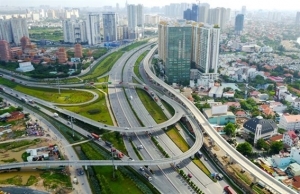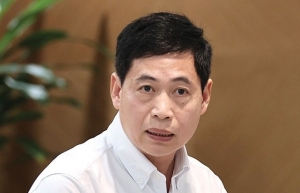Infrastructure value for money cannot be downplayed
What infrastructure development improvements in Vietnam have you witnessed in recent times?
 |
| Nguyen Ba Hung, principal country economist from the Asian Development Bank (ADB) in Vietnam |
Vietnam, with a rich history and vibrant culture, has experienced significant economic transformation over the past few decades. GDP per capita in 2010 constant price rose from around $600 in 1986 to over $3,600 in 2022, bringing the country from a less developed status to a middle income one.
Investment in infrastructure has been a prominent catalyst for the country’s development over the period, and the government put it among the strategic priorities to build an integrated and modern infrastructure system including transportation, focusing notably on roads, airports, and seaports, energy, and telecommunication. Vietnam has constructed a total length of primary, motorways, and highways around 25,000km, significantly improved connectivity within the country and with the neighbouring countries.
However, Vietnam’s infrastructure still lags behind other countries in the region. According to the most recent World Bank report, Vietnam is positioned 47th out of 160 countries in infrastructure rankings and 103rd in road quality as per the World Economic Forum’s ranking. Vietnam’s expansion and modernisation of roads, highways, railways, and ports have facilitated the movement of goods and people, reduced logistical bottlenecks and enhanced trade.
How has Vietnam ameliorated its infrastructures in energy, digitalisation, water, and waste treatment?
Access to energy nationwide has reached all of the population, while per capita energy consumption grew about three times. While power generation capacity, transmission and distribution networks continued to expand rapidly, the country has also diversified its energy sources, including a surge in renewable energy generation such as solar and wind power. These initiatives not only contribute to sustainable development but also enhance energy security.
Regarding digital infrastructure, as of the end of 2020, Vietnam had roughly 69 million internet users and 61 million smartphone users, with a penetration rate of 71 and 63 per cent respectively. The rapid development of the digital infrastructure enabled the fast growth of the digital economy.
Vietnam’s telecommunications service firms are expected to invest $2.5 billion to deploy and commercialise 5G technology from 2020-2025. The widespread adoption of mobile technology and internet services has not only connected people but also opened new avenues for business and innovation.
In the water and waste treatment sector, as of 2020, over 95 per cent of the population has access to at least basic water services, and about 90 per cent of the population has access to sanitation, albeit quality varies significantly. However, only over 70 per cent of solid waste is processed at dump sites, and most is discharged untreated. While certain progress has been made, with the fast urbanisation the need to upgrade urban infrastructure is becoming more urgent.
What is your take on Vietnam’s efforts to streamline procedures for infrastructure development?
In addition to overall economic infrastructure, Vietnam has established numerous investment-focused industrial and special economic zones have also been quickly developed with a strong focus on attracting foreign direct investment and promoting manufacturing both for exports.
These zones offer investors a range of incentives, including possible tax breaks and streamlined regulatory control and processing, leveraging on improved transport and energy infrastructure. They created large number of jobs to attract workers, thus driving rapid urbanisation.
Historically, total infrastructure investment was in the range of 8-10 per cent of GDP annually during most of the 2010s, but falling to around 5.7 per cent in recent years. Most infrastructure investment in Vietnam is currently financed from the central government budget, while official development assistance (ODA) from bilateral and multilateral partners used to be a significant source but diminishing as Vietnam reached the middle-income status.
Of the estimated $45 billion of cumulative ODA resources, about 53 per cent was used to finance infrastructure. Joining force with other partners, the ADB’s cumulative commitment of financing for infrastructure in Vietnam exceeded $10 billion.
These achievements in infrastructure delivery were also a result of the continuous improvement in the necessary legal frameworks and regulations to strengthen public and private investment in infrastructure development.
The Vietnamese government in recent years has put in place several laws on public-private partnerships, investment, and enterprises, as well as a decree on investment in key infrastructure projects. At the same time, Vietnam also improved the business environment for infrastructure investors, including reduction of the number of required permits and licences, streamlined approval procedures, and improving the transparency of the investment processes.
What new initiatives can be undertaken for infrastructure development in the country to truly blossom?
The significant achievements put Vietnam in a good position to continue accelerating and expanding its infrastructure, which is critical to maintain high growth and improve quality of life for long-term social and economic development. As such, Vietnam needs to continue investing about 9 per cent of its GDP for infrastructure.
The latest ADB estimates also indicated that Vietnam needs $167 billion over 2015-2025 for infrastructure investment if the country wants to maintain high economic growth. It is therefore important that the government mobilise sufficient resources, including through increased collaboration with multilateral and bilateral development partners to leverage their resources and capacity and experience.
The government could also undertake strategic initiatives to catalyse private investment to supplement public resources and improve attractiveness to private investors. This can be done by diversifying financing modalities with innovative structures to maximise the impact of scarce public resources, or increasing delivery capacity through public-private partnerships to improve operational efficiency.
This will also require regulatory and policy enhancements both in the financial sector to deepen the capital markets, and in infrastructure sectors towards improving cost recovery ability and financial sustainability of infrastructure investments. These can be supplemented with targeting social policies to support underprivileged and vulnerable groups to enhance social safety nets.
That will help better attract private investment into infrastructure sectors while ensuring inclusiveness in development.
Together with the aforementioned steps, the government also needs to strengthen their capacity to expedite the implementation of infrastructure projects, ensuring resilience to climate change and alignment with the net-zero transition. Experience showed that by collaborating with development partners, in addition to financing, the government can leverage their capacity and experience to improve project design and implementation, especially in executing new types of infrastructure like urban rail or mass transit.
The government also needs to improve the value-for-money of investments by adopting a whole-of-life approach that considers the costs of operation and maintenance in addition to the upfront capital expenditure. This will ensure the quality of infrastructure assets to deliver desirable economic and social impact.
Vietnam’s infrastructure will still need to grow significantly and fast, that requires significant investment. The government can achieve that with the efforts of the whole political system, and the help of bilateral and multilateral partners.
With its proven track record in developing and implementing infrastructure projects in Vietnam and other countries in the Asia-Pacific region, the ADB has a full suite of solutions to support governments to achieve this. They range from sector planning and regulatory improvement to project preparation and financing for public, private investments and public-private partnerships, as well as capacity building for central and provincial agencies.
With a strong commitment to infrastructure investment, Vietnam can collaborate more closely with development partners and the private sector for efficient implementation to realise its vision of integrated and modern infrastructure that will benefit the country and its people for years to come.
 | PPP model needs more balancing, equality for private investors Vietnam's increased demand for infrastructure development in the coming years requires governmental policies that encourage the private sector's participation, said economists and policymakers. |
 | Prospects bright for data centre and cloud infrastructure development Vietnam now has nine data centre operators, 30 cloud centres, 571,000 servers, and 54.7 million physical cores. Viettel Group operates 13 data/cloud centres, VNPT seven, and the rest run by other businesses. |
What the stars mean:
★ Poor ★ ★ Promising ★★★ Good ★★★★ Very good ★★★★★ Exceptional
Related Contents
Latest News
More News
- Positive projections for M&A interest from Thailand (December 03, 2025 | 09:40)
- Manifesting the first line of defence in cybersecurity (December 03, 2025 | 09:00)
- The transformational role AI can play in accounting arena (December 03, 2025 | 08:00)
- Unlocking 5G-AI potential in Singapore (December 03, 2025 | 08:00)
- Data-driven strategies vital for a fast-evolving nation (December 02, 2025 | 09:41)
- Policy to practice: how Vietnam can lead the region (November 26, 2025 | 16:03)
- Mobilising private capital at scale vital for climate battle (November 26, 2025 | 15:36)
- VILAF and Yoon & Yang launch Vietnam - Korea Practice Unit (November 26, 2025 | 15:16)
- Trademark disputes challenge foreign firms in Vietnam (November 24, 2025 | 15:30)
- Rich IPO pipeline can catalyse strategic dealmaking (November 17, 2025 | 11:36)

 Tag:
Tag:






















 Mobile Version
Mobile Version